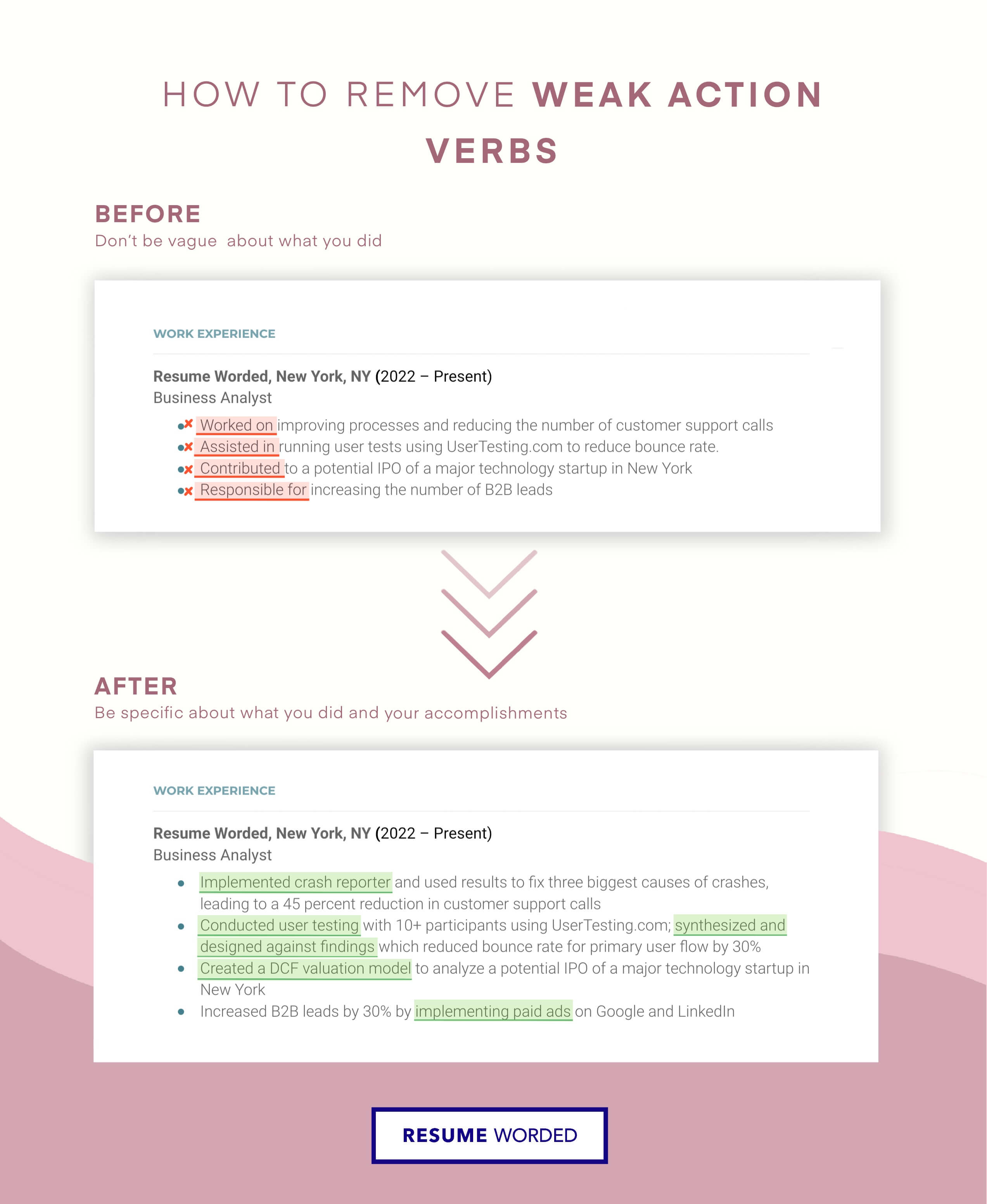Resume Synonyms for Doing
Want another word for Doing to use on your resume? Our team's compiled the most effective action verbs and synonyms you can use instead of the overused resume phrase, "Doing".
Want another word for Doing to use on your resume? Our team's compiled the most effective action verbs and synonyms you can use instead of the overused resume phrase, "Doing".
A resume is meant to showcase your past achievements as well as your future potential—using the verb 'doing' (the present participle of 'do') helps to demonstrate both of those things at once. It can also help establish your value by showing that the company will benefit from hiring someone with so much experience and knowledge.
However, when writing your resume, it's important to avoid using 'doing'—it's generic, weak, and not very engaging. It's also not very accurate when describing what you did. It's also worth noting that it's appropriate to write past achievements in the past tense—'did' instead of 'doing.'
In order to make your writing more effective, you should replace weak verbs with power verbs. For example, instead of saying 'Doing,' use action verbs like: 'Realized,' 'Repaired,' or 'Calculated.' These words are more powerful and specific than 'doing,' making them a better choice for writing that needs to be impressive.
Using power verbs over weak verbs such as 'doing' can help make your resume stand out from others in a significant way: it shows that you're taking ownership of your accomplishments and understand how your work contributed to the success of your company.
I've compiled some synonyms you can use instead of Doing on your resume, followed by real examples I've written for clients (feel free to use them!).
Let's look at examples of how you can remove and replace the overused phrase, Doing, with a stronger synonym and alternative that is more effective at highlighting your achievements.
• tasks like implementing tracking systems to ensure nothing gets missed
After: Using a stronger synonym• 15 tracking systems that improved accountability and ensured that 1.3K purchases were authorized before being released for shipment. .
• tasks such as organizing and planning events
After: Executed• 6 high-profit networking events, each with over 100+ attendees, leading to a 30% increase in customer engagement.
As a hiring manager, I appreciate when candidates use strong action verbs like 'Executed', which paints a robust image of their role. I made sure to include an specific number and direct impact ('30% increase in customer engagement') to highlight the candidate's accomplishments.
Tip: I've prepared a ton of additional examples for you to give you inspiration. Please click on any of the following to expand and see real examples of how I've rewritten client bullet points.
We've put together an infographic to give you more examples of how to put this into practice. Note the use of strong action verbs instead of words like Doing.

• company's 24-month sales results to develop five-year monthly projections by revenue and customer type.
• executed, and optimized digital marketing campaign on Google's AdWords for $20B CPG company, yielding 20% ROI improvements.
• ReferRoom to organize social events for 500 young professionals, and grew it to $20k/year revenue and $8k/year profit..
• execution of LBO in foodservice sector in South Africa, the PE fund's largest investment; led a team of four analysts; negotiated bank financing and developed hedging strategy.
• an iPhone app to help medical professionals measure the insulin needs of patients with diabetes.
• financial analysis to evaluate public and private financing alternatives to strengthen client's balance sheet.
Generic language like Doing are considered to be buzzwords because they're used so often. Consider using synonyms like Progressed, Repaired, Arranged, Resolved, Gathered or Fixed.
Here are some synonyms for commonly repeated words, like Doing, I see on resumes:
If you have a version of your resume ready, remember to get it checked using our free resume scanner below. It will make sure all your action verbs are strong enough, and give you feedback on any mistakes you might have overlooked, so you can fix them before a recruiter sees them.
Get expert feedback on your resume, instantly. Our free AI-powered resume checker scores your resume on key criteria recruiters and hiring managers look for. Get actionable steps to revamp your resume and land more interviews.
Upload Resume
"My free resume review was truly eye-opening. I found out why I wasn't getting interviews and exactly what to add to get past resume screeners. I've already had way more callbacks since I used it. I recommend it to all my friends who are job searching."

"Probably the best thing I've done this year. Showed me what my strengths were and the jobs and industries I should be focusing on. The most impactful part though was how it identified this spiral I'd been doing subconsciously - yikes, freakishly accurate."

Thank you for the checklist! I realized I was making so many mistakes on my resume that I've now fixed. I'm much more confident in my resume now.